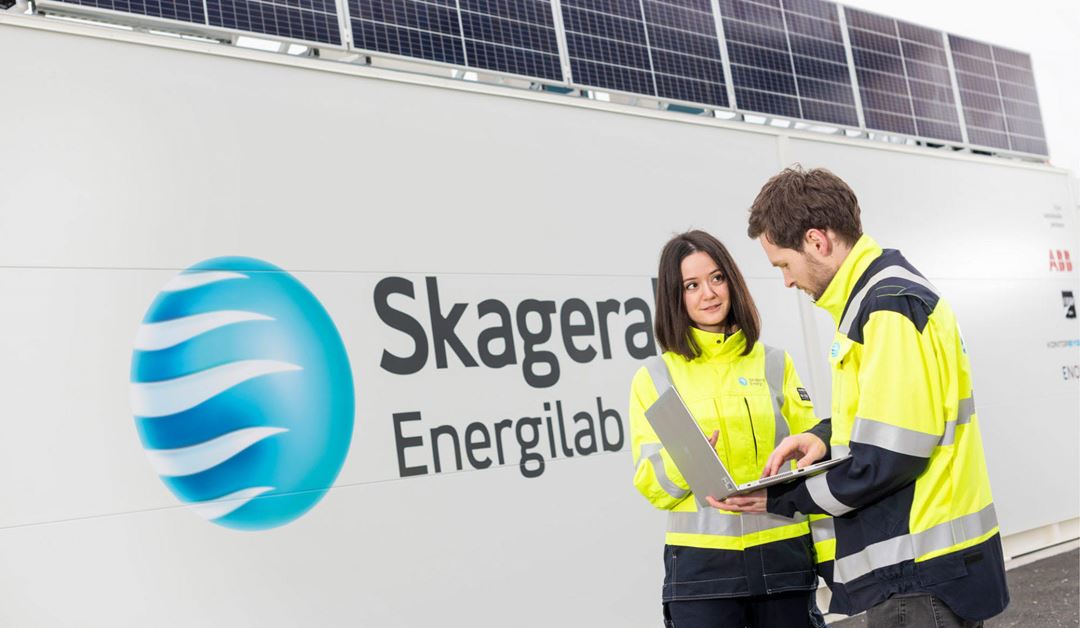When the battery is fully charged it has sufficient capacity to provide floodlighting for the stadium for the two hours it takes to complete a football match. The system also serves as a back-up source of electricity for households in the neighbourhood, and some electricity can be fed into the distribution grid.
“These homes and business premises are all incorporated in a microgrid”, says Signe Marie Oland at the grid company Skagerak Nett AS. Advanced equipment in the form of a distributed generator enables “islanding” in situations where there is an outage of the main grid “, she says.
Oland is also Project Manager at the energy laboratory and test facility Skagerak Energilab, which is owned by Skagerak Nett, one of the partners in the CINELDI research centre. When Oland showed the online energy technology magazine Energiteknikk around the facility on a dark and rainy day in November, production from the solar panels was running at rather low levels. However, over an entire year, the aim is for them to produce 660 MWh of electricity, enough to supply 35 homes.
Skagerak Energilab was officially opened this summer, while test plans and laboratory details were finalised in the autumn. The battery, the distribute generator with its air-insulated switchgear, and other electrotechnical equipment has been supplied by ABB, while the solar panels were delivered by FUSen.
Exciting variables
“Skagerak Energilab is providing us with an opportunity to find out how local solar power generation, combined with battery storage, can interact with the existing distribution grid”, says Oland. “There are many exciting variables linked to electricity consumption and grid management that the lab can test at full scale”, she says.
She goes on to add that Skagerak Nett obtains a lot of information that it can use from new AMS smart meters. Such information enables the company to predict how the battery should be charged and discharged during the day in order to boost the quality of electricity supplies to consumers. The equipment in the lab will make it easier to manage these huge data volumes.
Focus on R&D
“Like all electricity providers we will be facing major challenges in the years ahead, not least electrification, and we have to start finding some smart solutions”, says Oland. “Skagerak Nett is devoting a lot of attention to its R&D activities, and this is why we have invested in this unique facility”, she says.
The energy laboratory is full of advanced equipment that both Skagerak’s own scientists and visiting researchers will be able to use to carry out tests such as how the islanding of microgrids impacts on voltage quality and frequency.
Analysing consumption
“For example, we can carry out a number of different calculations and simulations, such as of production levels from the solar panels and the levels of consumption of customers on the following day. Then we can determine whether any surplus power should be stored in the battery or sold on the open market”, says Oland. “We are also able to analyse how capacity is used, and we can see what happens if peak load is spread out over a greater part of any given day.
An important goal for us is to achieve stable and efficient grid operation. We want to reduce wear and tear and maintenance and to look in more detail at how we can use the battery to carry out preventive work in relation to the grid. The battery has a number of functions that can make a contribution towards efficient operation of the grid, and we will be running tests on these”, she says.
Simulation of operation in island mode
Oland adds that it will be interesting to start running simulations of microgrid operation in island mode (islanding). “We have defined a number of microgrid “use cases” that we want to implement”, she says. “These may include looking into the impacts and opportunities linked to electric vehicle (EV) charging, as well as issues related to prosumers”, says Oland. She points out that a rapid charging station for EVs has been installed outside the stadium entrance.
Skagerak Energilab as a whole has cost NOK 30 million. Almost half of this has been paid for by a grant from the green energy funding organisation Enova, and these funds have made it possible for Skagerak to complete the project.
A wild idea
It all started as a wild idea in the head of the Odd football club Chief Administrator Einar Håndløkken. He has spent many years as an environmentalist, including a period as leader of the Norwegian Zero Emissions
Resource Organisation (Miljøstiftelsen Zero). Under Håndløkken, Odd has stated its clear ambition to become Norway's most eco-friendly football club.
The plans for the Skagerak Arena were put in motion, and Håndløkken was convinced that the extensive roof construction could be used for something useful such as the generation of eco-friendly energy. So he got in touch with Skagerak Energi, a long-standing business partner of the club, and the snowball started to roll. The outcome is the Skagerak Energilab.
Distinguished visit from China
This unique facility has also drawn a lot of attention from overseas. Just recently the laboratory was visited by the head of the Chinese State Grid Corporation (SGCC), one of the biggest energy companies in China, who was very excited about what he saw.
“We’re very proud of the completion of the Skagerak Energilab”, says Signe Marie Oland at Skagerak Nett. “It shows that we are an energy company with a progressive mindset and that we take our social responsibility for the sustainable development of the electricity grid seriously”, she says.


